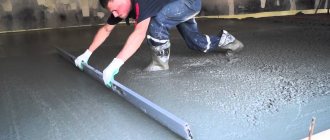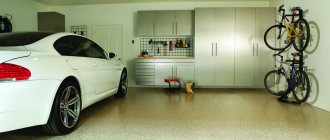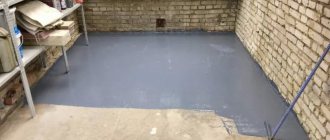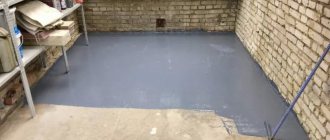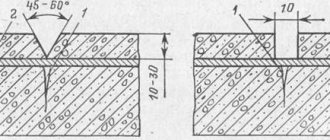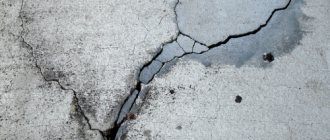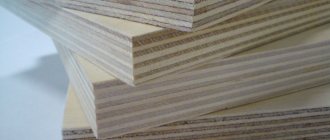As a rule, in private garages, reinforced concrete screed is used as a subfloor. The design has a lot of positive qualities: strength, reliability, durability and water resistance. At the same time, untreated concrete under the influence of external factors cracks, wears out and becomes very dusty. A well-chosen and correctly applied garage floor covering will help save the situation. Any car enthusiast can do a good job of finishing the base. First, you should familiarize yourself with the range of garage flooring.
What should the garage floor be like?
Not every flooring material can be used in a garage. The coating must meet the following requirements:
- withstand regular loads from the weight of the vehicle. In addition, heavy tools are often stored in garages, which also exert pressure on the floor;
- strength . The floor will bear not only loads from the car, but also from the fall of a heavy tool;
- moisture resistance . When it rains or snows outside (and in some regions there is snow for more than six months), the car on wheels and on the body will bring moisture into the garage, so the floor should not be susceptible to rotting and mold;
- resistance to aggressive substances . Car maintenance involves the use of gasoline, cleaner, antifreeze, oil and other substances that, if they come into contact with certain materials, can damage them. For a garage, you should choose a coating that is not afraid of such exposure and can be easily cleaned from stains;
- resistance to fire , since there will always be flammable liquids in the garage;
- resistance to temperature changes . Most garages do not have heating, and the air warms up there only when the car owner decides to tinker with the car. This means that the flooring will regularly suffer from temperature changes, and it is important that it does not become cracked or deformed.
You can also add cost-effectiveness , because, to be honest, everyone wants to get the maximum by spending the minimum.
The requirements are strict, but car owners have a choice of suitable materials. Let's try to figure out which garage floor is better, and what are the main pros and cons of popular materials.
What can be used as a coating
For painting work on concrete floors, paints made from alkyd or epoxy resins are used. They differ from others in that they have good anti-slip and antistatic properties. In addition, they of this type are highly resistant to chemicals with varying levels of aggressiveness.
- Epoxy resin paint must be pre-mixed and matched to the appropriate color. Alkyd does not require additional preparation. But before using it, the concrete surface must be primed. But paint made from epoxy does not need this.
- In addition to the mentioned materials, primers are used to coat concrete ; they are necessary for restoring concrete that has been in use for a long time. and lost its original appearance. The impregnations contained in the primer give the floor a bright color, and the polymers that are a component of the primer hide defects. The use of putties turns the concrete coating into a monolith. When selecting paint for concrete, it is advisable to take into account the characteristics of the room in which they are located. For example, where damage from mechanical impact is possible, it is necessary to create coatings with a high level of strength. In this case, it makes sense to paint the floor with wear-resistant materials.
- Floor varnish or enamel based on polyurethane is applied to self-leveling coatings For floors located in garages and for covering concrete structures used in landscape design, coatings are used that are used for floors in industrial buildings. These coatings are produced on the basis of epoxy enamels.
- For concrete placed in an apartment or private house, it is advisable to use water-based materials . For balcony structures, it makes sense to use polyurethane elastomers consisting of two parts. If the task is to ensure the water resistance of the coating, it is more advisable to use polyurethane-based coatings.
Now let’s look at what can be used to cover concrete floors and what is on the sales market.
Epoxy resin paint
This paint has good durability and this extends its life, in addition, such a coating can provide a neat appearance to the floor.
- It is highly resistant to mechanical impacts of various types. She calmly tolerates the effects of chemicals of varying levels of aggressiveness. In addition, epoxy resin paint has good adhesion to concrete. This type of coating does not change its color or fade. It has increased resistance to wear and therefore is used in rooms where active movement of vehicles and personnel is expected.
- Paint based on epoxy resin allows its use on areas located on the street, because it is impervious to atmospheric influences. By the way, it can be applied to freshly poured concrete.
Attention: However, this coating has one drawback. It consists of two substances and they must be mixed before using it. In addition, changing the color of the floor is almost impossible.
Acrylic based paint
In essence, it is an aqueous composition with an acrylic resin base. This composition stops the corrosive destruction of concrete.
- It forms a film that limits the action of destructive factors. The film formed by acrylic paint has good reliability and durability.
- In addition, it does not allow moisture to pass through. These and some other characteristics allow the use of this material for finishing floors in garages, loggias and balconies, etc.
- The coloring material is applied with brushes, rollers and sprayers. You can increase the effectiveness of the coating by applying it in two layers.
Attention: A floor coated with acrylic coating can begin to be used after 12 – 14 hours.
Polyurethane based enamel
Enamels of this class consist of two components, but this does not affect the quality of the created coating. Paints of this type are used for floors (see Cellar floor: manufacturing options), which are located both indoors and outdoors.
Option #1. Dirt floor
This option for arranging the floor can be described as “cheap and cheerful.” It is unlikely to be suitable for those who intend to build a major garage that will ensure complete safety for the car and comfort for its owner. This is a solution for cases of extremely limited budget.
Advantages of an earthen floor in a garage:
- relative cheapness of arrangement;
- minimal time investment;
- Only minimal construction skills are required.
disadvantages :
- an earthen floor is a source of dust and dirt, and all this will settle on the car and things stored in the garage. If the ground is dry, then when cars and people move, dust will rise. If water gets into the garage (for example, when it’s raining outside), then there will immediately be a lot of dirt in the garage;
- in winter the garage will be very cold;
- there is no possibility of insulation;
- You will constantly have to add soil and compact it, since noticeable depressions will form along the trajectory of the car.
Installing a dirt floor in a garage is quite simple. Work begins when the walls have already been erected. First, the fertile layer of soil is removed, this is approximately 15-40 cm depending on the region, then the base is covered with plastic film or geotextile - this is protection against grass germination. Now all that remains is to fill the hole with soil. First, a layer of no more than 5 cm is poured, it must be thoroughly compacted, then more soil is added, compacted again, and so on until the required level is reached. Please note that it is necessary to make a slight slope towards the gate.
What is required from a concrete screed
In order for the selected paint to behave as stated by the manufacturer and expected by the consumer, the concrete base must meet certain requirements.
It is clear that the screed itself, with its strength characteristics, must meet the conditions of garage operation. The best option for arranging a garage floor would be concrete of grade M300 strength. It is made from Portland cement PC400, crushed stone and sand, taken in a proportion by weight of 1.0: 3.7: 1.9.. or by volume 1.0: 3.2: 1.7.
If you paint old floors that have cracked or have potholes, then the paint will not only not be able to hide these flaws, but it will not stay on such a surface for a long time. With such a careless approach to coloring, all financial investments, as well as the time and effort spent, will be in vain. That is, identified defects in the concrete surface must be repaired before applying paint.
Therefore, before you start choosing paint for the garage, you need to inspect the base. And if necessary, make a complete or at least partial repair of the surface.
Prices for concrete floor paint
concrete floor paint
Option #2. Concrete floor
Concrete garage floors are a classic . Concrete can be the basis for further finishing, or it can be used on its own. Most garage owners prefer concrete floors, and for good reason.
Advantages:
- high strength and durability, the ability to withstand severe loads, however, the magnitude of these loads greatly depends on the grade of concrete;
- Smooth surface;
- resistance to moisture, fire, temperature changes and most aggressive substances;
- absence of harmful fumes;
- low cost;
- the opportunity to carry out the work independently.
A concrete floor is an almost ideal solution for arranging a floor in a garage, but this option also has some disadvantages :
- the floor surface is very cold, so if you spend time there often and for a long time in winter, you will have to think about a heating system;
- if you do not treat the concrete with anything, it will wear off and become dusty over time;
- the complexity of organizing a concrete floor;
- To make the work go faster, you will need special equipment.
The garage floor can be constructed using prefabricated concrete blocks or by pouring concrete directly on site. The use of ready-made blocks will significantly speed up the process of organizing the floor covering; moreover, the characteristics of factory blocks are stable and are tested by the factory. On the other hand, transporting heavy finished blocks will require special equipment, and there will be seams between the individual slabs, which is why the technology of pouring a monolithic slab is usually used.
To equip a concrete floor , first remove the soil to a depth of 20-30 cm, fill it with about 10 cm of crushed stone, compact it, arrange a sand cushion of about 10 cm, which is also thoroughly compacted. A cement screed with a thickness of about 2 cm is laid on the sand, then a waterproofing material (for example, roofing felt) is laid, and only after that it is the turn to carry out the main pouring of the concrete floor (5-7 cm thick), and it must be reinforced with steel reinforcement. As the concrete screed dries, it is periodically moistened with water. This will prevent the formation of cracks and ensure proper strength to the concrete. Naturally, the floor is made with a slope towards the gate.
When the concrete has gained strength, the garage can be safely used, i.e. use the screed as an independent floor covering. Some people prefer not to dwell on this and use concrete only as a basis for further finishing of the floor, for example, with porcelain stoneware, tiles, or for pouring a self-leveling floor.
The simplest option for finishing a concrete floor is painting , and it becomes mandatory if, after drying, you rub the screed with the sole of your shoe and sand appears. Such a floor will not last long, therefore it needs not so much decorative finishing as protection.
Methods of strengthening
To strengthen the floor, a topping system is used for further exploitation of the concrete surface independently and strengthening the base for various decorative coatings.
Topping strengthening mixtures consist of crystalline high-strength rocks: quartz, corundum, metal powder, mineral additives.
After treatment, the surface becomes durable and abrasion-resistant. When using a topping system, floors acquire a super-durable coating when the work is carried out correctly. Strengthening begins when the screed hardens. If you can walk on hardened concrete, but moisture still appears on the surface, the floor is rubbed with a special apparatus - a “helicopter”.
Main stages of strengthening:
- They go over a wet concrete surface with a trowel.
- Sprinkle the topping mixture over the surface and spread. The mixture should be saturated with moisture from the screed.
- Thoroughly scrub the floor. The top layer of screed and the topping mixture should form a homogeneous mass.
- After the first layer of hardening powder has been grouted, the remaining third is again scattered over the surface in an even layer and left for 3-5 hours. It will draw out any remaining moisture in the concrete.
- Then the floors are carefully rubbed down again.
- If the decorative coating will not be laid on the treated surface, you can grout it several more times.
It is best to carry out the process of hardening the lining of rubber, PVC or ceramic tiles. The finish can be painted. You can also lay a self-leveling floor device on the concrete.
Option #3. Self-leveling floors
The use of self-leveling floors allows you to quickly obtain a perfectly flat surface. Mixtures for self-leveling floors differ in composition and purpose. For example, cement and gypsum mixtures are usually used to level the floor. They do not allow you to create a decorative finishing coating, but with their help you can very quickly and easily get rid of minor irregularities. Such compositions are inexpensive and quite easy to use. To level the floor in the garage before finishing, it is better to use a cement self-leveling floor, since gypsum is sensitive to high humidity.
Another thing is polymer self-leveling floors , which are considered the finishing coating. The basis for them will be a concrete screed, on top of which a cement self-leveling floor can be used, since the base must be perfectly level.
The advantages of polymer self-leveling flooring include the following qualities:
- durability of the coating, which is measured in decades;
- resistance to temperature changes and frost, which is not uncommon in a garage;
- resistance to aggressive chemicals;
- fire resistance;
- moisture resistance;
- hygiene and ease of cleaning.
Minuses:
- high cost of coverage;
- difficulties during the repair process. If any area of the coating is suddenly damaged, it will be problematic to repair it due to difficulties in selecting the right shade.
The properties of the coating will depend on the composition of the material used . Polymer self-leveling floors are:
- polyurethane floors are the most expensive, require very careful preparation of the base, but at the same time they are characterized by the greatest resistance to shock loads and vibrations. The coating perfectly withstands the effects of aggressive substances, moisture, and it is not afraid of falling heavy objects. In addition, the coating is resistant to temperature changes, it is easy to care for, and cracks and scratches are relatively easy to restore - even if you manage to damage the floor, the area of deformation will need to be sanded and varnish applied on top. It turns out to be an ideal flooring option for a garage, but distribution is hampered by the high price;
- Methyl methacrylate flooring is great for garages. The coating is durable, wear-resistant, moisture-resistant, and can withstand the effects of chemically active substances. In addition, the floor hardens very quickly, and within a few hours after installation is completed you can walk and drive on it. The disadvantage is a strong odor during drying, but with proper ventilation it quickly dissipates. During operation of the coating, no foreign odors will appear;
- Epoxy floors also withstand abrasion, moisture, aggressive substances, and temperature changes well. The coating is hard and durable, but it has a significant drawback - it is afraid of impacts. Therefore, if you often make something in the garage and use a lot of heavy tools, then it is better to look towards other materials. If there are no particularly heavy objects that could fall in the garage, then an epoxy self-leveling floor is suitable for you;
- cement acrylic floor - this is the same cement self-leveling floor, but its characteristics are improved due to the presence of a polyacrylate copolymer in the composition. The coating is moisture-resistant, resistant to aggressive substances, non-slip, and can withstand mechanical loads well, but due to its low elasticity, cracks may occur on the surface.
The garage is not a place for intricate decor, but still some car owners will appreciate the opportunity to slightly transform the room where they spend a lot of time. Polyurethane and epoxy self-leveling floors can be painted in any shade , and if desired, even decorative chips (paint particles of different shapes and sizes) can be added to the composition to imitate the surface of granite, marble, etc. You can, of course, apply a design, use a 3D image, and put coins, sand or other decorative elements under a layer of transparent flooring, but this is hardly appropriate in a garage.
Why does dust and other defects appear?
Operating conditions in the garage contribute to the formation of dust and other defects, these include the following:
- the car itself, which moves in and out of the garage every day;
- due to the lack of heating, the humidity in the garage is increased, which negatively affects the condition of the concrete floor;
- negative temperatures;
- aggressive chemical compounds (motor oils, fuels and lubricants, etc.)
Dust and defects on the concrete floor.
Option number 4. Rubber floor
Another option that meets all your garage flooring needs is rubber flooring. The material is based on crumb rubber, which is mixed with adhesives, various modifiers and dyes. This mixture is used to produce rolls, tiles, mats, and liquid rubber.
Advantages:
- good resistance to shock loads, so the material does not care about the fall of heavy objects, and it can easily withstand the weight of the car;
- resistance to aggressive substances, moisture, temperature changes;
- good thermal and sound insulation performance;
- non-slip surface;
- high elasticity, therefore it is comfortable to walk on the rubber floor;
- durability;
- ease of care.
The material is not recommended for use near open fire sources - this limitation is the main disadvantage of the coating.
rolls is best suited for the garage . The thickness ranges from 2 to 12 mm; there is cord reinforcement, which gives the material additional strength. You can find rolls of different shades on sale; the coating is relatively easy to install, but over time it can peel off in the corners. Modular tiles also performed well, from which you can lay out a pattern on the floor. Installing such a covering is relatively simple, and in case of damage, individual tiles can be easily replaced - you just need to take extra material in advance. Another option is to create a seamless coating by spraying liquid rubber. The main disadvantage of this option is the fear of shock loads.
Painting with rubber paint
Painting a concrete floor with rubber paint
Rubber paint will solve several problems at once - protect the screed from water and chemicals, get rid of dust and give the floor a presentable appearance. Rubber has good adhesion and holds very firmly to the base.
In order for the painting to meet the required parameters, the following conditions must be met:
- Compliance with the purpose of use. The packaging must contain appropriate labels. Such solutions have anti-slip and antistatic properties.
- The need for preliminary leveling and primer coating. This process is long, step-by-step, but without it it is impossible to achieve the desired effect. It is also necessary to take into account that both liquids must have the same composition.
- The penetrating solution must be applied twice at intervals of up to 12 hours after complete drying. Painting is allowed only on a completely dry surface. If the primer is not absorbed in places, it must be removed with a rag.
- Rubber paint is sold ready for use; there is no need to dilute it with anything. If you want to get a beautiful floor color, you can add pigments of the appropriate composition.
- During operation, a strong specific odor is released. During the application process, it is advisable to use a respirator, organize effective ventilation, and avoid the use of fire and electrical appliances with open coils.
The liquid must be applied two or three times, in thin layers, after each pass, waiting until it dries completely and changing the direction of movement of the tool.
Option #5. Paving slabs
An original solution for arranging flooring in a garage is to use paving slabs. Not only will the garage have an aesthetic appearance, but the material itself meets all the requirements for garage finishing.
Advantages:
- high strength - such a floor can easily withstand regular loads from a moving car;
- moisture resistance;
- fire resistance;
- excellent appearance, the ability to lay out a pattern;
- ease of care;
- relative ease of installation.
as a disadvantage , but if you search, you can find more or less affordable options, but you shouldn’t go to extremes - tiles that are too cheap are unlikely to be of high quality. Often such products are made in small factories with poor equipment and without adherence to technology, so the quality will be appropriate. As for installation, it is better to entrust it to professionals, but if you have some skills in the field of construction, you can try to do everything yourself.
Give preference to tiles with a rough surface - they will not slip. You should not take tiles that are too textured, as it will be more difficult to clean them from dirt.
The process of laying tiles in general is as follows. A layer of soil 20-30 cm thick is removed, a layer of gravel about 10 cm thick is poured in, thoroughly compacted, a layer of sand about 5 cm thick is poured on top of it, and also compacted. After this, a layer of sand is poured onto which the tiles will be laid. Each element is carefully deepened into the sand cushion, the cracks are filled with sand or a mixture of sand and cement.
Results: what material to choose?
Now you know what flooring options are available for your garage, you can choose the one that is right for your situation. If you want to save money and get a durable and reliable floor, you can choose paving slabs.
If you have enough budget, you can order clinker tiles or porcelain tiles, which will be wear-resistant and durable. Rubber floors are a beautiful and safe option.
Analyze the properties and cost of materials and make the right choice in accordance with your desires and finances.
Option number 6. Porcelain tiles
This is not an option for those whose budget is limited. Although the material is ideal for a garage, it is expensive, which is why it is used quite rarely. Porcelain stoneware is made by mixing clay, sand, feldspar, pegmatite and water. The mixture is subjected to high pressure and then high temperature. The result is a material that is not inferior in strength to natural stone.
Advantages:
- wear resistance and ability to withstand heavy loads;
- resistance to moisture and fire;
- resistance to temperature changes;
- durability up to 50 years;
- ease of care;
- great appearance.
The disadvantages , in addition to the price, include low thermal insulation qualities, as well as fragility, therefore it is necessary to transport porcelain stoneware with extreme caution. Lay the material on top of the concrete screed.
Heating and insulation
It is very important to create an optimal temperature regime in the garage, not only for its storage, but also for its maintenance. Many car enthusiasts believe that it is enough to insulate the walls and ceiling. In such cases, during severe frosts, condensation may form on the floor.
SNiP 02/21/99 states that the optimal temperature in a car storage room should be about 15 degrees.
Therefore, it is very important to insulate the floor in the garage; this will create favorable conditions for its storage.
During the construction of a garage floor, depending on the coating used, it is advisable to insulate it. Materials that can be used for floor insulation:
- Expanded clay. It has good heat and sound insulation. Durable, non-toxic. Resistant to temperature changes.
- Styrofoam. Not very heavy, moisture resistant, not expensive.
- Expanded polystyrene. High heat and sound insulation characteristics. Resistant to deformation, temperature changes, waterproof.
- Mineral wool. Fireproof, resistant to mold and mildew.
Option No. 7. Acid resistant tiles
Naturally, we are not talking about the tiles that lie in the bathrooms and decorate the walls in the kitchen - such tiles will not withstand the loads typical of a garage. Special acid-resistant tiles, which are usually used in workshops of industrial enterprises, are suitable. The material is produced on the basis of refractory clay, to which substances are added that provide resistance to negative environmental factors.
Pros:
- high strength and ability to withstand heavy loads. The material can easily withstand the weight of heavy factory machines, so it will certainly withstand garage loads;
- moisture resistance;
- resistance to aggressive substances;
- resistance to temperature changes and frost;
- the tiles do not absorb grease and dirt, therefore they are easy to clean;
- The non-slip surface will make moving around the garage safe in any weather.
Among the minuses, one can note, perhaps, a small assortment of tile shades, but when we are talking about arranging a garage and not an apartment, then this nuance can hardly be considered a serious minus.
Tiling concrete
This solution is literally on the surface, since this type of finishing is present in almost all residential and office premises. The tile reliably covers the base from moisture and mechanical stress. The adhesive used to lay the tiles creates an additional layer of waterproofing. However, there is one nuance to consider here. Ceramic tiles are a slab of fired clay on which a thin layer of paint is applied.
The tiles themselves are designed to withstand light traffic loads created by pedestrians. In the garage, conditions are completely different. Car wheels will wear off the decorative coating in a matter of months. Don't forget about hard, heavy objects stored in the garage. From their movement and falling from shelves, a lot of chips, cracks and scratches occur on the tiles.
So, ceramic tiles are not suitable for the garage; a more durable material is needed. It is porcelain stoneware made from sand and composite polymers. Porcelain tiles have a uniform structure throughout their entire volume and incredible strength. The only condition is the absence of voids under the cladding. You can lay the tiles yourself, without involving specialists.
For this work you will need:
- building level;
- mallet;
- Bulgarian;
- serrated steel spatula;
- rubber spatula;
- tile adhesive;
- grout for seams;
- plastic crosses;
- protective glasses.
Laying the tiles begins from one of the far corners of the garage. First, the entire surface of the concrete is cleaned of debris, dust and oil stains, and then primed. The correctness of the masonry is controlled by plastic crosses, a level and a mallet. After the solution has hardened, the seams between the tiles are sealed with a special waterproof grout. You can use finished floors a day after finishing work.
Option No. 8. Wooden floor
It is difficult to think of a more unsuitable material for a garage floor, but, nevertheless, many car owners still prefer this option. Why? Yes, because wood has its advantages:
- low price;
- ease of installation. All work can be done independently;
- ease of repair. If any part of the floor is damaged, you can easily replace several boards;
- good thermal insulation properties of wood make staying in the garage more comfortable;
- environmental friendliness.
many disadvantages:
- wood is afraid of moisture, can rot, or be affected by fungus;
- wood is flammable;
- spilled fuels and lubricants are easily absorbed into the wood structure;
- wood wears out quite quickly from constant contact with car tires.
To minimize the negative properties of wood, it must be coated with protective compounds that will increase the material’s resistance to moisture and fire, and protect it from attacks by insects and mold. Paint will provide additional protection. It is better to choose the most moisture-resistant species for the garage, for example, larch.
The wooden floor is laid out from boards with a thickness of at least 40 mm, and it is better to take boards with a thickness of 50 mm or more. The wooden floor is laid on logs, which are used as wooden blocks.
Installation of beacons
Control beacons under the floor screed allow the floor to be poured as evenly as possible. Ordinary wooden blocks can become beacons. After installing the reinforcing mesh, we take the bars and align them parallel to the walls. Beacons are set to zero level. The distance between the beams should be convenient for leveling the concrete mixture as a rule.
After installation, the two parallel beacons are leveled with a water level and the beams are leveled as much as possible. Some builders use a thread during the pouring process, which will control the evenness of pouring concrete. Beacons are installed in stages during the pouring process.
Any flat and long objects can be used as beacons
Option number 9. Steel floor
Corrugated steel panels can be used as garage flooring. This option is not very common, but has many advantages :
- high strength and wear resistance, the ability to withstand significant loads;
- resistance to shock loads - even a fall of a heavy object will not leave cracks on the floor;
- non-slip surface;
- the material does not generate dust, therefore it is easy to clean;
- durability.
The downside is the high price. Installation of steel plates is simple, but it is impossible to cut them yourself, so you need to take the correct measurements and order products with the necessary parameters.
The need for dust removal, and what to cover with
Additional protection of the concrete floor allows you to increase the strength of the material and significantly reduce the amount of dust generated. To do this, at the stage of garage construction, dry cement or a layer with polymer toppings is laid on top of the fresh mortar. If this procedure was neglected at the initial stage of pouring the floor, the floor is covered with:
- tree;
- ceramic tiles;
- rubber plates or PVC.
You can also polish the concrete or make a self-leveling floor. Each of the proposed options requires relatively high costs. The best way to remove dust from a garage is to apply paint to the floor.
Types of coatings
Types of coatings differ not only in appearance and cost, but also in the complexity and technology of their installation. So, you can finish the floor covering in the following ways:
— surface painting;
— self-leveling floor;
— facing with ceramic or paving slabs;
- wooden flooring;
— laying rubber and PVC plates;
— treating the floor with a topping system or sanding.
Almost all types of flooring require a concrete screed, and for some, additional strengthening of the base is indispensable; the first step is to consider a topping system.
How to make a semi-dry screed with expanded clay
A semi-dry screed with expanded clay is the only option where careful preparation of the base is not required. It is enough just to sweep the surface, remove construction debris from the cracks and remove moisture. All wires located under the floor are hidden in corrugation and carefully pressed to the base.
- The surface is covered with solid PVC film or a special vapor barrier, which will protect the expanded clay from moisture from below.
- The level of the new screed is marked using a construction or laser level. A line is drawn on the wall.
- A gap of 10 centimeters is left along the walls; thermal insulation material is inserted here, which will additionally provide good sound insulation.
- Expanded clay is poured out and distributed over the entire surface using the usual rule.
- The solution is poured onto expanded clay, or it can be separated with a thin layer of waterproofing.
Metal Garage Flooring
After the soil has been leveled and the garage has been installed on the gravel bed, you have to start insulating and finishing the walls and floors with your own hands. The main types of materials for flooring in a metal garage:
- concrete screed;
- clinker or porcelain tiles;
- rubber cover;
- polyvinyl chloride boards;
- bulk polymer mixtures;
- wooden flooring.
Concrete screed will be required in any case - both under tiles, and under wooden boards and under self-leveling floors. Concrete is a very popular material for DIY repairs, because at a fairly low cost it has a number of positive characteristics: it is durable, wear-resistant, easy to clean and sand, and can be combined with any finishing coating. In order to prevent cracking and dust formation from concrete, it is enough to impregnate it with special polymer mixtures, which will strengthen the surface layer and enhance its water-repellent properties.
